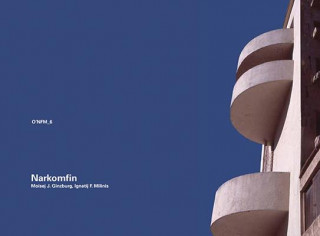
Code: 02924225
Moisej J. Ginzburg, Ignatij F. Milinis: Narkomfin, Moscow 1892-1946
by Danilo Udovicki-Selb
Der sechste Band der O'Neil Ford Monograph-Reihe, herausgegeben vom Center for American Architecture and Design (CAAD) und dem O'Neil Ford Chair in Architecture an der University of Texas at Austin. Jede dieser Monografien in engl ... more
- Language:
 English
English - Binding: Paperback
- Number of pages: 192
Publisher: Wasmuth, 2016
- More about this

195.62 zł

Low in stock at our supplier
Shipping in 10 - 14 days
Potřebujete více kusů?Máte-li zájem o více kusů, prověřte, prosím, nejprve dostupnost titulu na naši zákaznické podpoře.
Add to wishlist
You might also like
-

Diamond Deception
123.97 zł -

Homicide in American Fiction, 1798-1860
117.59 zł
Give this book as a present today
- Order book and choose Gift Order.
- We will send you book gift voucher at once. You can give it out to anyone.
- Book will be send to donee, nothing more to care about.
More about Moisej J. Ginzburg, Ignatij F. Milinis: Narkomfin, Moscow 1892-1946
You get 113 loyalty points
 Book synopsis
Book synopsis
Der sechste Band der O'Neil Ford Monograph-Reihe, herausgegeben vom Center for American Architecture and Design (CAAD) und dem O'Neil Ford Chair in Architecture an der University of Texas at Austin. Jede dieser Monografien in englischer Sprache analysiert ein wichtiges Bauwerk moderner Architektur in fundierten Essays und an Hand von zahlreichen Fotos, Originalskizzen und Plänen. Die schön aufgemachten Bände ermöglichen so dem Leser ein ausgesprochen detailliertes Studium ausgesuchter architektonischer Werke.§§ §The House of the Narkomfin was built, or better, "Montage" - as the Constructivist Moisej J. Ginzburg (1986-1946) preferred to call it - between 1928 and 1931. It is therefore contemporaneous with Le Corbusier's Villa Savoye, as well as with Le Corbusier's visit to Moscow. On a superficial level, they both share a common aesthetic that in France was nicknamed "le style paquebot," while the Narkomfin was soon called the "The Steamer," or even the "Agit-Steamer" in a symbolic reference to the boats of the Agit-Prop movement that carried the message of the Revolution along the rivers of the Soviet Union.§§On a deeper level, the Narkomfin is more than a housing block with a recognizable style. It is the converging point of the history of Constructivism. It is the most sophisticated expression of a "social condenser," in Ginzburg's words, where purposefully reassembled functional spaces are given an active role in transforming everyday social life. Echoing the Russian Formalist method of analytic editing, like the cinematic "montage of attractions" - to use Eisenstein's expression - it stems from reconfigured semantic series of the notion of traditional abode, intended to transform everyday life - the "byt." In this sense, the Narkomfin - a building without precedent - is more than a symbol; it is, in a nutshell, the very program of Constructivism. It is also the zenith of five years of intensive experimentation under Soviet Russian government sponsorship, from 1926 and 1930, with new ways of dwelling, boasting emancipatory social relationships for women in particular.§§Intended for the working class, these industrialized dwelling types sought ways to raise numbers without sacrificing quality. Widely transcending the confines of Soviet architectural practice itself, the Narkomfin anticipated by twenty years Le Corbusier's own experimental housing block in Marseille, which resulted directly from his visit to Moscow in 1928.§The Narkomfin was also the last building Ginzburg's Society of Contemporary Architects (OSA) built with its team of brilliant young professionals, trained at the VHUTEMAS (the Soviet 'BAUHAUS'), Mihail Barsc in the first place. The 1930 Bolshevik Central Committee decree condemned the experimentation as "phantasies that would alienate people from the very idea of Socialism." The effort was now seen, under Stalin's "Revolution from above," as diverting resources from the main goal of the 1928 Five-Year-Plan, aimed exclusively at rapid industrialization of the country. "Temporary" wooden barracks, lacking essential living amenities, supplanted in a permanent way OSA's innovative drive for affordable ways to raise the living standards of all, eliminating in the first the plague of shared apartments. Ginzburg's resistance to the new trend, known as Socialist Realism, resulted however as late as 1938, in a sanatorium at Kislovodsk (the Caucasus) with front façades designed in the "Novecento" style to elude censorship. Hidden behind the sanatorium's main façades - the only likely to be photographed - were tangible quotations of Le Corbusier's, Mies van der Rohe's, and Gropius' architecture, including fragments of his own Narkomfin.
 Book details
Book details
195.62 zł
- Full title: Moisej J. Ginzburg, Ignatij F. Milinis: Narkomfin, Moscow 1892-1946
- Author: Danilo Udovicki-Selb
- Language:
 English
English - Binding: Paperback
- Number of pages: 192
- EAN: 9783803007889
- ISBN: 3803007887
- ID: 02924225
- Publisher: Wasmuth
- Weight: 790 g
- Dimensions: 298 × 217 × 12 mm
- Published: 2016
Trending among others
-

Dune
35.21 zł -33 % -

Haunting Adeline
124.88 zł -2 % -

Berserk Deluxe Volume 2
213.64 zł -1 % -

White Nights
11.22 zł -26 % -

Powerless
47.46 zł -14 % -

Atomic Habits
59.50 zł -26 % -

Dune Messiah
46.55 zł -3 % -

Berserk Deluxe Volume 3
221.23 zł -

One Day
32.78 zł -36 % -

Berserk Deluxe Volume 1
212.83 zł -2 % -

Iron Flame
63.24 zł -26 % -

Surrounded by Idiots
37.94 zł -26 % -

Harry Potter and the Prisoner of Azkaban (Minalima Edition)
171.23 zł -2 % -

Gravity Falls Journal 3
90.06 zł -

Heaven Official's Blessing: Tian Guan Ci Fu (Novel) Vol. 1
89.46 zł -1 % -

The Creative Act
100.69 zł -15 % -

Dune
38.25 zł -38 % -

Hunting Adeline
130.75 zł -1 % -

A Little Life
48.77 zł -12 % -

Children of Dune
46.95 zł -2 % -

Heaven Official's Blessing: Tian Guan Ci Fu (Novel) Vol. 2
96.24 zł -

Bungo Stray Dogs, Vol. 8 (light novel)
64.66 zł -6 % -

Percy Jackson and the Olympians 5 Book Paperback Boxed Set
194 zł -1 % -

Solo Leveling, Vol. 1
88.95 zł -1 % -

The Prisoner's Throne
43.61 zł -15 % -

Court of Thorns and Roses
43.61 zł -15 % -

Cry Baby Coloring Book
48.47 zł -

Fourth Wing
72.25 zł -15 % -

Icebreaker
34.30 zł -28 % -

Berserk Deluxe Volume 6
219 zł -

Avatar, the Last Airbender: The Kyoshi Novels (Box Set)
170.02 zł -2 % -

The 48 Laws of Power
101.70 zł -13 % -

House of Leaves
86.22 zł -33 % -

Twisted Lies
36.93 zł -28 % -

Dune Messiah
47.76 zł -23 % -

No Longer Human
54.34 zł -21 % -

48 Laws Of Power
86.52 zł -14 % -

Twisted Games
37.94 zł -26 % -

Caraval Paperback Boxed Set
176.39 zł -3 % -

Solo Leveling, Vol. 2
75.39 zł -23 % -

Open Circuits
170.42 zł -2 % -

Berserk Deluxe Volume 5
218.90 zł -

Heaven Official's Blessing: Tian Guan Ci Fu (Novel) Vol. 3
84.30 zł -7 % -

Berserk Deluxe Volume 4
222.85 zł -23 % -

Court of Mist and Fury
36.73 zł -26 % -

SOLO LEVELING V08
88.85 zł -2 % -

English File Upper Intermediate Multipack A (4th)
93.50 zł -1 % -

CHAINSAW MAN V14
34.10 zł -26 % -

Before the Coffee Gets Cold
34.10 zł -26 %
safisfied customers
Since 2008, we have served long line of book lovers, but each of them was always on the first place.
Copyright! ©2008-24 libristo.pl All rights reservedPrivacyPoučení o cookies


 21 million books
21 million books Delivery 12.99 zł
Delivery 12.99 zł (32) 444 93 66 (8-15.30h)
(32) 444 93 66 (8-15.30h)